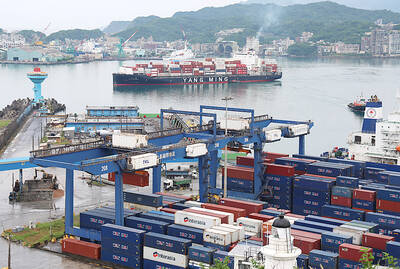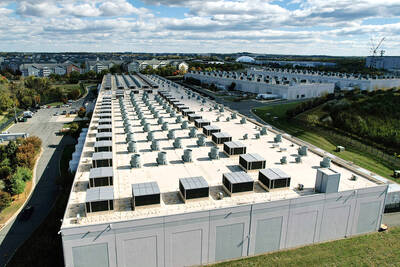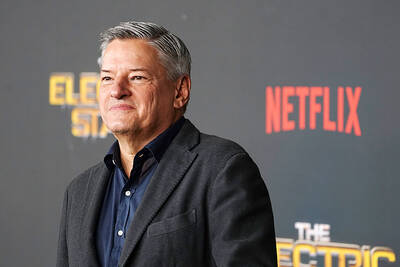A free-fall in petroleum stocks was the most striking element of an otherwise lackluster week on Wall Street.
All three indices finished higher for the holiday-shortened week, although the gains in both the Dow and S&P 500 were modest. Markets were closed on Thursday for the Thanksgiving Day holiday and closed three hours early on Friday.
The Dow tacked on 18.18 points (0.1 percent) at 17,828.24, while the S&P 500 rose 4.06 (0.2 percent) to 2,067.56. The tech-rich NASDAQ Composite Index jumped 78.66 (1.67 percent) to 4,791.63.

Photo: Reuters
For November as a whole, the Dow rose 2.52 percent, the S&P 500 2.45 percent and the NASDAQ 3.47 percent.
Petroleum stocks were on the defensive most of the week as investors warily awaited the OPEC meeting on Thursday in Vienna.
OPEC had not been expected to respond aggressively to a roughly 35 percent drop in oil prices since June, but the cartel did even less than many experts predicted, opting not even to promise to stop pumping above its current 30 million barrels per day production ceiling.
“OPEC is clearly signaling that it will no longer bear the burden of market adjustment alone and this decision puts the onus on other producers, especially US tight oil to adjust as well,” Barclays said.
On Friday, Dow members Exxon-Mobil and Chevron fell by 4.5 percent and 5.5 percent, respectively. Oil services companies like Halliburton and Nabors Industries also declined by 10.9 percent and 12.9 percent respectively, along with shale producers Continental Resources (down 19.9 percent) and EOG Resources (down 7.8 percent).
However, the oil price drop had an upside, as airline stocks gained on expectations of lower fuel costs and retailers were lifted as the start of the annual holiday shopping season coincided with an OPEC decision that many analysts see as a boost to consumers’ disposable income.
“Lower gasoline prices are assisting in making holiday spending and confidence rather elevated. Even though consumer spending on gasoline is slightly less than 3 percent of disposable income, it plays a more significant role on consumer mood,” Chris Christopher of IHS Global Insight said.
The US National Retail Federation has predicted that holiday sales this year would rise to US$616.9 billion, up 4.1 percent from last year’s level. Holiday sales accounted for about a fifth of the retail industry’s annual sales last year.
Key factors behind the better outlook include a lengthier holiday shopping season compared with last year, when Thanksgiving fell late in the calendar, and better overall economic data.
In terms of last week’s economic reports, the biggest positive surprise was the US Department of Commerce’s second estimate of third-quarter economic growth, which was revised to an annual rate of 3.9 percent from 3.5 percent. Analysts had expected a downward revision to the initial estimate.
Other reports were mixed. Data for last month showed a slight increase in US consumer spending, a dip in consumer confidence, a rise in durable goods orders and a modest increase in new-home sales. The reports, while somewhat disappointing, “weren’t terrible,” said Michael James, managing director of equity trading at Wedbush Securities.
“Nothing about the data was enough to alter the view that the US economy remains the strongest economy in the world and that US equities remain the best option among worldwide equity markets,” he said.
Next week’s calendar includes the US Federal Reserve’s “Beige Book” of economic conditions and this month’s car sales and jobs report.

Taiwan’s exports soared 56 percent year-on-year to an all-time high of US$64.05 billion last month, propelled by surging global demand for artificial intelligence (AI), high-performance computing and cloud service infrastructure, the Ministry of Finance said yesterday. Department of Statistics Director-General Beatrice Tsai (蔡美娜) called the figure an unexpected upside surprise, citing a wave of technology orders from overseas customers alongside the usual year-end shopping season for technology products. Growth is likely to remain strong this month, she said, projecting a 40 percent to 45 percent expansion on an annual basis. The outperformance could prompt the Directorate-General of Budget, Accounting and

The demise of the coal industry left the US’ Appalachian region in tatters, with lost jobs, spoiled water and countless kilometers of abandoned underground mines. Now entrepreneurs are eyeing the rural region with ambitious visions to rebuild its economy by converting old mines into solar power systems and data centers that could help fuel the increasing power demands of the artificial intelligence (AI) boom. One such project is underway by a non-profit team calling itself Energy DELTA (Discovery, Education, Learning and Technology Accelerator) Lab, which is looking to develop energy sources on about 26,305 hectares of old coal land in

Netflix on Friday faced fierce criticism over its blockbuster deal to acquire Warner Bros Discovery. The streaming giant is already viewed as a pariah in some Hollywood circles, largely due to its reluctance to release content in theaters and its disruption of traditional industry practices. As Netflix emerged as the likely winning bidder for Warner Bros — the studio behind Casablanca, the Harry Potter movies and Friends — Hollywood’s elite launched an aggressive campaign against the acquisition. Titanic director James Cameron called the buyout a “disaster,” while a group of prominent producers are lobbying US Congress to oppose the deal,

Two Chinese chipmakers are attracting strong retail investor demand, buoyed by industry peer Moore Threads Technology Co’s (摩爾線程) stellar debut. The retail portion of MetaX Integrated Circuits (Shanghai) Co’s (上海沐曦) upcoming initial public offering (IPO) was 2,986 times oversubscribed on Friday, according to a filing. Meanwhile, Beijing Onmicro Electronics Co (北京昂瑞微), which makes radio frequency chips, was 2,899 times oversubscribed on Friday, its filing showed. The bids coincided with Moore Threads’ trading debut, which surged 425 percent on Friday after raising 8 billion yuan (US$1.13 billion) on bets that the company could emerge as a viable local competitor to Nvidia